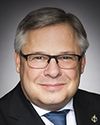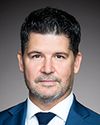Thank you. Hello, everyone.
I would first like to thank the committee for inviting me to discuss the research that is being performed in the field of plasma physics at the Gérard Mourou Center for Ultrafast Optical Science. My name is Brandon Russell, and I am a research fellow at the University of Michigan, where I recently completed my Ph.D. in electrical engineering.
Although I am currently working in the United States, I grew up in Alberta and attended the University of Alberta for my undergraduate degree. During my time at the University of Alberta, I was initially involved in research in the field of nanotechnology. However, through an internship at the Stanford linear accelerator national laboratory in California, I was introduced to the field of plasma physics. This is an extremely exciting and impactful field of research, and I have been passionate about it ever since.
My graduate studies were focused on progressing the high-energy frontier of this field, wherein large ultra-intense lasers are used to create extremely energetic plasmas. My current research is focused on creating the theoretical framework needed to design experiments for the next generation of laser facilities that are currently being constructed around the world, including the extreme light infrastructure, ELI, in Europe and the ZEUS laser system at the University of Michigan, which will be the focus of this speech.
Prior to the funding of ZEUS in 2019 by the National Science Foundation, the University of Michigan had the Hercules laser system. Hercules was a mid-scale laser system, taking up several standard laboratory spaces. This laser was built under the leadership of Gérard Mourou, using the technology of chirped pulse amplification for which he jointly won the Nobel Prize in 2018. This technology allowed the laser to reach extremely high intensities, large enough to accelerate electrons to a significant fraction of the speed of light. In fact, the Hercules laser held the Guinness world record for the most intense laser in the world. Many experiments were run on this laser, both by students and researchers at Michigan and by external collaborators. These experiments studied a diverse range of topics, including particle acceleration, X-ray generation for medical and materials studies, and the study of magnetized processes relevant to astrophysics.
Since then, many similar laser systems have been constructed throughout the world, including many more powerful lasers called petawatt laser systems. For reference, the United States power grid operates at around one terawatt, a thousand times less than the power of the laser pulses generated by these petawatt laser systems.
In North America, many of these laser systems belong to LaserNetUS, a network of laser systems that researchers can apply to for time to run their own experiments. Although the majority of these lasers are at U.S. institutions, the Advanced Laser Light Source in Quebec also belongs to this network.
These mid-scale laser facilities allow us to tackle scientific problems with a significant impact at the level of fundamental science and with the potential to have great societal impact. Some of these problems include accelerating electrons to energies comparable with those of conventional several-kilometre-long particle accelerators, creating compact X-ray sources for diagnosing advanced materials and ultra-fast medical imaging, proton acceleration for cancer therapy, and nuclear fusion as an alternative energy source.
However, it should be noted that nuclear fusion experiments are generally performed at large-scale laser facilities, including the National Ignition Facility in California. Recently, there has been an international push—largely in the United States, Europe, and Asia—to develop a new generation of multi-petawatt lasers that can access an extremely energetic regime of physics where strong-field quantum-electrodynamic processes can be studied. These processes that appear in this regime are theorized to occur in the most extreme astrophysical environments, like those surrounding black holes and highly energetic stars known as pulsars.
Given a high enough laser intensity, we could access this regime by simply shooting a laser into a vacuum. However, such intensities are far outside the reach of current laser technology. Instead, we can achieve similar results by colliding a high-energy electron beam head-on with a laser beam. Several facilities around the world are currently racing to apply this concept, including the University of Michigan, where the ZEUS laser has been purpose-built for this concept.
The ZEUS laser was funded by the National Science Foundation to be a user facility where researchers can apply to run their own experiments. The facility recently ran its first experiment, successfully demonstrating operation of the first components of the laser system, and it is expected to begin operation at full power in late 2023. At that time, it will be the most powerful laser in the U.S.
This facility has already brought together talented scientists and students for the design and construction of the laser, and it will continue to bring in researchers internationally to perform experiments. Collaborating on novel, highly impactful experiments at this facility will allow students to receive a unique set of skills and gain useful connections for their future careers.
For these reasons, I believe the work being done at the University of Michigan and generally in the field of plasma physics is in line with the motion adopted by the committee. I hope that what I have talked about can give insight into how laser-plasma physics, which already exists at a few institutions in Canada, may be expanded upon to bring in talented researchers.
I would, again, like to thank the committee for giving me the opportunity to speak about this work being done at the Gérard Mourou Center for Ultrafast Optical Science at the University of Michigan. I am happy to take any questions.
Thank you.



